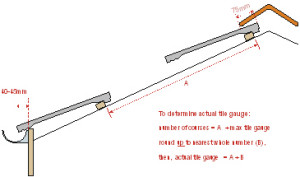Installation guidance
The following information is for general guidance only. The designer and fixer should ensure that tiles are installed in accordance with BS 5534: The British Standard Code of Practice for Slating and tiling. Local conditions and current good practice should also be considered.
All work on site should be carried out in accordance with BS 8000-6: The British Standard Code of Practice for Workmanship on building sites.
Storage
Large format single lap tiles are generally supplied shrink wrapped on wooden pallets and should be stored on firm, level ground.
Ventilation and Dry Systems
Guidance on the installation of ventilation and dry fix systems can be obtained from the tile manufacturer.
Ventilation should be installed to comply with the recommendations given in BS 5250 and dry systems should be installed to resist the maximum design wind load for the site.
Underlay and Tile battens
Guidance on the installation of underlay and tile battens is given in Section 7.
Setting Out up the roof (Gauge)
Set the first batten at eaves to allow the tails of the eaves course tiles to overhang the fascia by 40 to 45mm, ie; just short of the centre of the gutter.
Set the last batten at the ridge so that the ridge tiles will overlap the top course of tiles by at least 75mm. See drawing below.
Measure the distance (A) from the first, eaves course batten to the top course batten. Divide this distance by the maximum tile gauge. Round the answer up to the nearest whole number (B) – this gives the number of tile courses required. Divide A by B to determine the actual batten gauge. Fix the remaining battens at this gauge.
Alternatively, it is technically possible to set out most of the roof at maximum gauge and then reduce the gauge of the last few courses to avoid having a cut course at the ridge. But care must be taken to ensure that doing this will be aesthetically acceptable.
Setting out across the roof
Lay a course of tiles along the eaves, setting the tiles at the average linear coverage. At this stage, some adjustment in shunt could be made, if necessary, to allow a 38 to 50mm overhang at verges. Ensure verge overhang is equal at left and right ends. Mark the position along the eaves and top battens of every third tile.
Alternatively, take a gauge rod (ie a short length of tile batten) and mark the position of three tiles with their sidelocks fully closed, then mark the position of the three tiles fully ‘open’. Set the average coverage by making a third mark midway between the previous 2 marks on the rod. Use this third position to mark out along the eaves and top battens.
Strike a chalk line from eaves to ridge at each mark. Tiles can be laid to these marks to ensure perpendicular lines remain straight.
Tile Fixing Generally
Load out all sides of the roof uniformly, randomly mixing tiles from different pallets.
Lay tiles starting at the right hand side of the roof plane and working towards the left. Use fittings supplied by the manufacturer.
Make sure that every third tile is positioned to the chalk line.
Mechanical fix all tiles in accordance with the manufacturer’s fixing specification.

